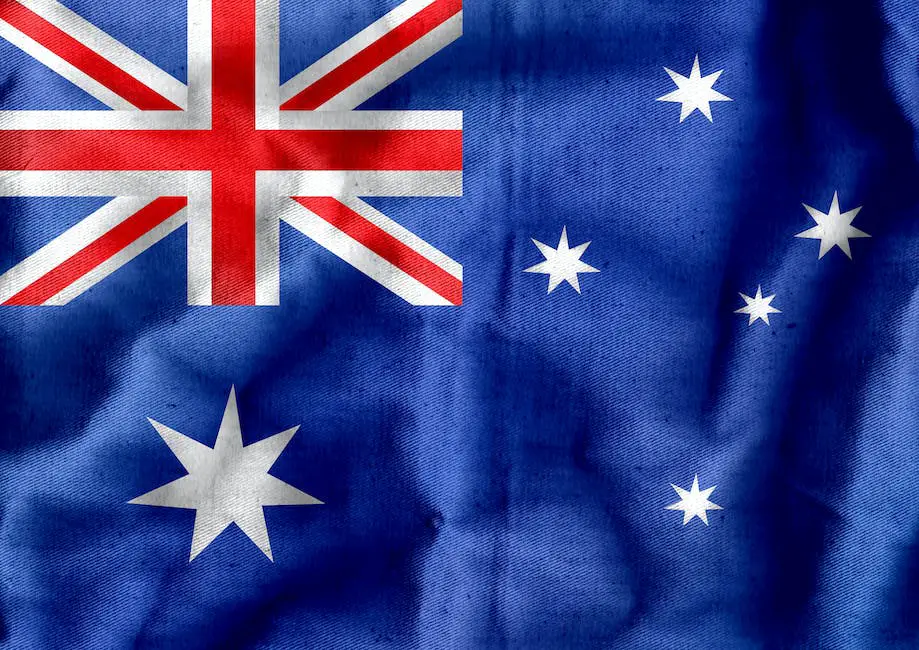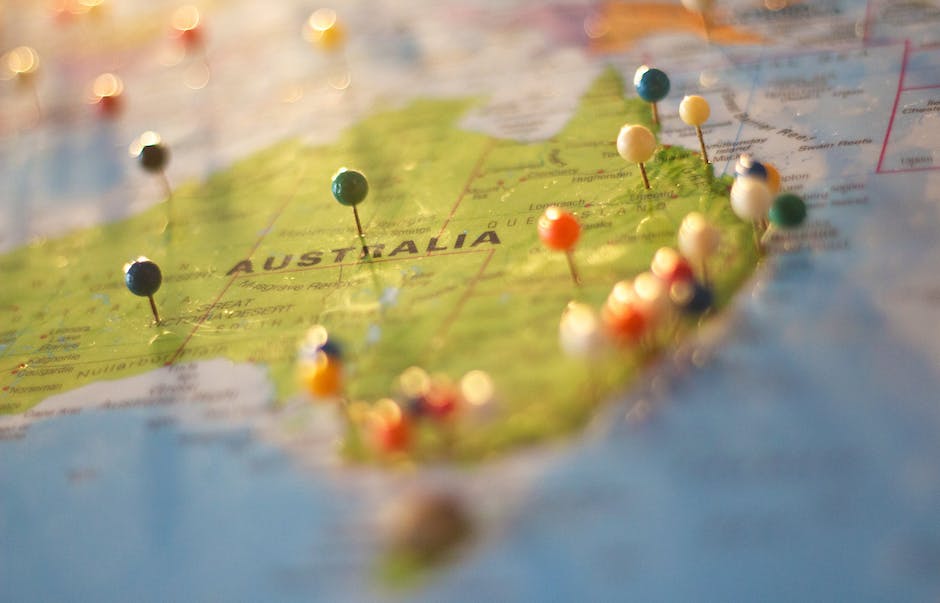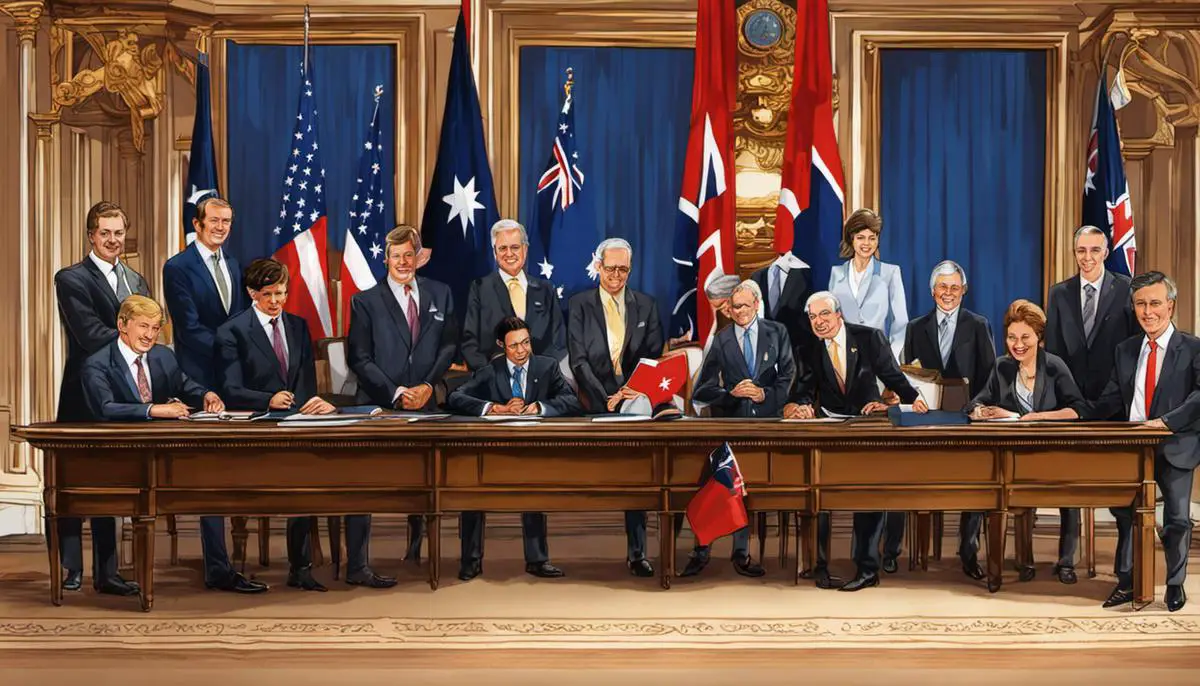The vibrant nation of Australia, with its diverse culture, booming economy, and advanced political institutions, is a testament to a historical journey from being a remote British colony to a fully-fledged independent nation. The path to independence, initiated by the arrival of the First Fleet in 1788 and culminating with the Australia Act in 1986, is marked by a sequence of significant events, key figures, and groundbreaking legislation. An understanding of this evolutionary process provides an invaluable insight into Australia’s current global positioning, its relationship with the UK, and its internal governance structure grounded in the Constitution.
Colonial Era of Australia
The Arrival of the First Fleet
Australia’s path to independence began with the arrival of the First Fleet in 1788. This fleet, composed of 11 ships carrying convicts from Britain, was led by Captain Arthur Phillip. The fleet’s arrival in Botany Bay marked the establishment of the first British penal colony in Australia and the advent of European settlement. The indigenous population, the Aboriginal people, was estimated at around 750,000 and lived across the continent, but the colonization had severe repercussions on the native population.Establishment of Penal Colonies
Australia was initially considered as a solution to Britain’s pressing problem: an abundance of convicts and an absence of somewhere to house them. The American War of Independence had eliminated Britain’s ability to send convicts across the Atlantic, so a new location was sought. Therefore, Australia was designated primarily as a penal colony.Colonial Expansion and Conflicts
As the number of free settlers from Britain began to increase in the early 1800s, separate colonies were established in Tasmania (1803), Western Australia (1826), South Australia (1836), Victoria (1851), and Queensland (1859). With this colonial expansion, tension and conflicts rose between the settlers and the indigenous population. The Aboriginal people, who had lived on the continent for tens of thousands of years, faced displacement, disease, and violent clashes, commonly referred to as the Frontier Wars.Gold Rush and Immigration Boom
The discovery of gold in the mid-19th century led to a massive increase in Australia’s population. The gold rush meant people from all around the world arrived in Australia, impacting the colonial economy and society. This led to increased demands for self-governance, signaling a shift from a penal colony to a more autonomous collective of colonies.Road to Federation
The Australian colonies progressively gained more autonomy from Britain throughout the 19th century. The Australian Colonies Government Act of 1850 granted the colonies significant legislative powers, while the introduction of ‘responsible government’ between 1855 and 1890 gave them power over most of their internal affairs.The Federation and Birth of a Nation
The six colonies—New South Wales, Victoria, Queensland, South Australia, Western Australia, and Tasmania—on the continent federated in 1901. This marked the birth of the Commonwealth of Australia, which maintained legal connections to Britain but defined its own constitution, parliamentary system, and national policies.Formal Independence
Australia’s independence wasn’t formally recognized until 1942 when the Statute of Westminster Adoption Act was passed, retroactively applying from September 1939. This Act officially acknowledged that Britain could no longer legislate for Australia. The Australia Act of 1986 further severed remaining judicial ties to Britain, making the High Court of Australia the highest court of appeal.Influences on Australian Identity
The historical stages of being a colony have undeniably helped shape the unique Australian identity. The tumultuous journey, featuring various struggles and conflicts leading up to the eventual federation and independence, has undeniably played a significant part in molding modern, multicultural Australia. This dynamic country draws from a rich tapestry of influences, comprising of the indigenous Aboriginal legacy, the effects of British colonial rule, and the waves of migrants from across the globe.
Pathway to Federation and Independence
The Road to Federation: The Influential Role of Sir Henry Parkes
In the year 1851, the British Parliament divided the Australian continent into six separate colonies – New South Wales, Victoria, Tasmania, South Australia, Western Australia, and Queensland. Each of these colonies effectively functioned as independent entities, with their own unique sets of laws, cultural norms, and trade practices, extending until the 1880s. It was during this crucial juncture in Australia’s history that Sir Henry Parkes, who is often referred to as the ‘Father of Federation’, stepped into the limelight. He was the first to voice the idea of a Federated Australia in a speech given in Tenterfield, NSW, in 1889. This acted as the catalyst for the much-needed discussions about the necessity for a consolidated national government.
The Conferences and Conventions: A path towards Federation
Inspired by Parkes’s proposal, a series of vital conferences and conventions followed to discuss the prospect of uniting the colonies. The Australian Federation Conference in Melbourne in 1890 and the Australasian Federation Convention in Sydney in 1891 were among these instrumental gatherings. James Robert Dickson, who was Premier of Queensland from 1898 to 1899, also played a key role in advocating for Queensland’s participation in Federation.
Federation in 1901: Formalization of Australian Unity
The ongoing efforts of statesmen like Parkes and Dickson eventually led to the federation of Australia on January 1, 1901, after a majority of people in each colony approved the Australian Constitution in a series of referenda. This marked the establishment of the Commonwealth of Australia, uniting the six colonies into a singular federation while still under the British Crown, with a federal government to handle matters of national and international importance.
Statute of Westminster Act: Australia’s Legislative Independence
The next major step towards full Australian independence was the passage of the Statute of Westminster in 1931 by the UK Parliament. This legislation removed legal restrictions on self-governance in the Dominions, including Australia, enabling them to enact their own laws independent of British law. However, Australia did not adopt the Statute of Westminster until 1942, with it applied retroactively from 1939.
Australia’s Journey Toward Complete Independence
The long road to complete legislative independence for Australia came to an end with the passage of the Australia Act in 1986. This imperative Act, enacted by both the British and Australian parliaments, eradicated any residual authority the UK held over Australia’s legal processes and terminated the UK’s right to create Australian law. Therefore, although Australia achieved federation in 1901, it was not until 1986 that Australia truly attained total legislative independence.

Australia’s Constitution and its Significance
Establishment of Australia’s Constitution: A Leap Towards Independence
The composition and incorporation of Australia’s Constitution was a major milestone in its path to independence. The journey started in the 1890s when conventions were organized for the creation of the Constitution by some of the country’s most respected figures such as Sir Edmund Barton, who later served as Australia’s first Prime Minister, and Sir Samuel Griffith, a renowned jurist and politician.
Confrontations over trade, immigration, and inter-colonial tariffs heightened the urge among these colonies to unite. The need to establish a federal government system spurred the constitutional convention debates which took place from 1891 to 1897. The outcome of these debates was the framing of the Australian Constitution, embodying the fundamental vision of ensuring a democratic form of governance and upholding the rule of law.
Significance of the Australian Constitution
Australia’s Constitution carries remarkable significance in underlining Australia’s independence. It not only established a federal system of government, blending British parliamentary, American federal, and French arbitral traditions, but also served as an emblem of Australia’s sovereignty. This Constitution marked Australia’s transition from a collection of independent British colonies to a unified, independent nation.
Although the Constitution was technically an act of the British Parliament, it was uniquely created by Australians and approved in popular referendums by the people of Australia. It formally came into effect on January 1, 1901, known as the Federation of Australia.
Formation of the High Court of Australia: A Crucial Turning Point
The formation of the High Court of Australia further emphasized Australia’s independence. Established in 1903 under the Judiciary Act passed by the Parliament of Australia, the High Court served as the ultimate court of appeal and became indispensable to the judicial system. The ability to interpret the Constitution and to nullify laws contradicting the Constitution provided the court with a powerful tool of judicial review. Judicial independence underscored Australia’s status as a sovereign nation.
The first justices of the High Court were also key figures in drafting the constitution including Samuel Griffith and Edmund Barton, who was appointed the court’s first Chief justice. The High Court’s authority in deciding constitutional matters unequivocally affirmed Australia’s autonomy in its governance, free from British legal oversight.
The Constitution of Australia stands as an enduring testament to the hard-earned independence of the country and is an important symbol of its democratic sovereignty. Australia’s judiciary, led by the High Court, ensures the consistent enforcement and interpretation of the Constitution. This steadfast commitment to constitutional law consolidates Australia’s status as a fully independent nation.

Australia’s Relationship with the United Kingdom Post-Independence
The Evolution of Australian Independence and Its Continuing Relationship with the UK
On the 1st day of January in 1901, the legal culmination of the Commonwealth of Australia was achieved. The six self-administering British colonies of New South Wales, Victoria, Queensland, South Australia, Western Australia, and Tasmania came together to form a federal system of government, thereby establishing Australia as a dominion within the British Empire. Independence, from an international standpoint, was not clearly defined until the enactment of the Statute of Westminster in 1931. Further, the passage of the Australia Act in 1986 broke the last remaining legal ties with the United Kingdom.
Following its independence, Australia maintained a close political bond with the United Kingdom. This bond is most evident in Australia’s continued association with the Commonwealth, an intergovernmental organization composed of 54 member countries, most of which were former territories of the British Empire. This political fraternity embodies shared values and historical ties. Australia’s involvement in the Commonwealth spans a range of activities, including cooperation on economic and social development initiatives, participation in sporting and cultural events, as well as collective efforts to manage contemporary global challenges.
Role of the British Monarchy Post-Independence
The monarchy of the United Kingdom holds a prominent, albeit controversial, role in Australia’s modern political structure. Despite the country’s legal independence, Australia remains a constitutional monarchy, with the British monarch as its reigning monarch and head of state. The monarchy’s executive powers are carried out by a Governor-General, who is nominated by the Prime Minister of Australia. Australian Monarchists and Republicans have long-debated the relevance and desirability of this arrangement, with both sides presenting arguments that range from upholding tradition and stability to advocating for full sovereignty and democratic representation.
Post-Independence Economic and Cultural Connections
Following its independence, Australia hasn’t completely severed ties with the UK. On the contrary, strong economic and cultural links persist between the two countries. The UK remains among Australia’s top trading partners, accounting for substantial bilateral trade and investment. A recent demonstration of this thriving trade relationship is the free trade agreement between them, aiming to abolish tariffs and enhancing economic cooperation.
Cultural links are also quite pronounced, with common elements including language, law structures, and social institutions. Moreover, a large population exchanges between the two countries are noticeable, exhibiting plenty of British settlers in Australia and vice versa. Thus, despite its sovereign status, Australia’s relationship with the UK is still prominently interlaced on numerous fronts.

Modern Independence and Australia’s Global Positioning
The Australia Act: Defining Australia’s Independence
Australia’s independence from the United Kingdom was concretely affirmed on March 3, 1986, with the passage of the Australia Act. This legislation effectively curtailed the UK’s legal influence over Australian law and constitution. Although Australia had enjoyed a significant degree of self-governance preceding this date, the passing of the Australia Act is often deemed the formal pronouncement of Australian independence.
The Australia Act negated the British parliament’s potential to legislate concerning Australia, affirmed a free and voluntary loyalty to the Crown, and rescinded the British Government’s oversight of state governments in Australia. With this Act, the final remnants of British legal authority were duly swept away.
Australia’s Position in Global Politics Post-Independence
Australia’s standing in the global arena was strengthened following the implementation of the Australia Act. As a fully independent nation, Australia began redefining its alliances and position in international politics freely and autonomously. The Act allowed Australia to develop its own foreign policy approach and build alliances that aligned more closely with its national interests.
Economic Implications and Agreements
Independence also led to economic implications and changes in Australia’s agreements with other nations. Though the Australia-New Zealand Agreement for Closer Economic Relations was implemented in 1983, prior to the Australia Act, it indirectly showed that Australia was taking steps towards defining its economic positioning and interests on its own terms.
Post-independence, Australia joined The Organisation for Economic Co-operation and Development (OECD), The East Asia Summit (EAS), and signed free trade agreements with numerous countries, pointing to an independently governed nation pursuing its economic interests and forging global trade relationships on its own accord.
Australia’s independence also reflected in its economic and fiscal policies, independently handling its monetary affairs and regulations.
Geopolitical Alliances
Australia has managed to build robust alliances globally post-independence. While it maintains a strong alliance with the United States, often attributed to shared democratic values and mutual defense interests, it also participates in forums like the G20, the United Nations, and the Commonwealth of Nations.
Australia is also a member of the Association of Southeast Asian Nations (ASEAN) Plus mechanisms, the Asia-Pacific Economic Cooperation (APEC), and the Indian Ocean Rim Association (IORA), seeking to strengthen its ties with neighboring Asian countries.
In conclusion
The Australia Act of 1986 didn’t just confirm Australia as an independent nation; it’s a milestone that allowed Australia to freely choose its alliances, build new economic relationships, and assert its stand in global politics.

Australia’s evolution from a distant British colony to an independent nation illuminates a captivating tale of tenacity, strategic alliances, and the quintessential quest for autonomy. This self-sovereignty isn’t just about political autonomy or economic freedom, but a nuanced layering of legislative evolution, significant world events, and the shifting dynamics of global politics. Resonating through each stage of Australia’s independence journey is the enduring spirit of a country continually shaping its destiny, reflecting the narratives of its Aboriginal heritage, colonial past, and modern democratic ethos. Undeniably, it is this complex past and the ensuing lessons learned which underscore Australia’s robust approach to diplomacy, international relations, and its position within the world stage today.






